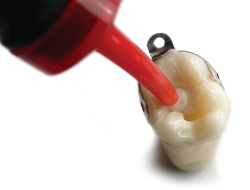Surefil one – a new class of restorative material
Featured ProductsPosted by: Dental Design 26th October 2021

Restorative clinician and trainer, Dr Ian Cline explains why he has started using Surefil one™, a new class of restorative material, particularly in time-sensitive cases.
Until now, there has never been a Class II restorative material available in the UK that can be placed quickly enough for time-sensitive cases, as well as be relied upon to last, without chipping or fracturing.
This has presented restorative clinicians with a real challenge, those faced with treating children, anxious patients, or those who have special needs or who experience difficulty keeping their mouths open for extended periods have had few options when it comes to restorative materials.
A new solution for time-sensitive cases
Dentsply Sirona has recently launched a new class of restorative material which meets the needs of these cases. Surefil one™, is a self-adhesive composite hybrid, which requires no etching or bonding before placement. It is the ultimate bulk fill, dual cure material, self-curing chemically once placed and then being light-cured by the clinician. Finishing and polishing then completes the restorative process.
Surefil one uses MOPOS (Modified Polyacid System), a patented technology which contains a polymer that chemically bonds to the tooth – like a self-etch adhesive. The cross-linking groups within this molecule create a strong and durable bond which makes Surefil one’s wear resistance comparable to a good quality composite.
Unlike amalgam, Surefil one provides a good aesthetic result and although amalgam is often the choice when there are financial constraints, it is seldom the patient’s first choice and is not a long-term solution, considering dental amalgam is currently being phased out.
Glass ionomers are another option for clinicians trying to minimise treatment time, but although quick to place, they are prone to chip and bulk-fracture and I do not use glass ionomers in anything other than Class I cavities.
In contrast Surefil one combines the simplicity of a glass ionomer with the stability of a conventional composite and also delivers a good aesthetic result, which is more than satisfactory in posterior restorations.
A new technique

The unique chemistry of Surefil one means that the technique for placing it is totally different to placing composites or glass ionomers. It is crucial for clinicians to understand the process before trying it for the first time. However once the technique has been mastered, dentists and their patients will quickly reap the benefits.
Part of its attraction is Surefil one’s short working time of 90 seconds, however this also means that there is only time to create a basic anatomy whilst bulk-filling. To overcome this, I tend to create the anatomy at the finishing stage, which still enables me to deliver a good aesthetic result.
Standing the test
Despite its recent emergence on the UK market, Surefil one has been in development for several years and has been the subject of extensive in-house clinical trials at Dentsply Sirona, all of which are documented in its scientific manual.
Its shear bond strength to both dentin and enamel is comparable to highly rated universal adhesives on the market and its low wear resistance is comparable to good-quality composites, and considerably better than the glass ionomers tested.
When it comes to Class II restorations, fracture resistance is extremely important. In a chewing simulation test, Surefil one was found to have similar fracture resistance to a composite placed with a seventh-generation bonding agent.
In a small clinical evaluation (1,294 restorations) of post-operative sensitivity in Germany, where Surefil one has been on the market for several years, <1% reported post-operative sensitivity. Whilst in a US study, the majority of dentists said that Surefil one was better than the material they currently used in compromised clinical situations.
With such results, I predict that Surefil one will become a Class II restorative solution that clinicians turn to when time is short, or the case is comprised. It provides a fast, durable and aesthetic outcome in the most demanding clinical conditions.
Watch Ian Cline’s on-demand webinar, ‘Restorative materials for time sensitive cases; more innovation, less clinical compromises’.
To find out more about Dentsply Sirona’s new Surefil one, please visit https://www.dentsplysirona.com/en/explore/restorative/surefil-one.html
You can visit the online Dentsply Sirona Academy for a wide range of education resources, video tutorials, courses and CPD webinars at dentsplysirona.com/ukeducation.
Earn Dentsply Sirona Rewards on all your restorative solutions at dentsplysirona.com – all the solutions you need under one roof.
Facebook: @dentsplysirona.uk
Twitter: @DENTSPLY_UK
Instagram: @dentsplysirona.uk
Dr Ian Cline
Ian Cline is a practice partner at Bloomsbury Dental Practice, a guest lecturer at King’s College London MSc programmes in Aesthetic Dentistry and Fixed & Removable Prosthodontics, and Course Director at Dental Education Resources (DENTER).








